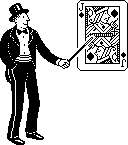How to analyze discards, part 3
![]()
 |
|
This article concludes our three-part study of
discarding. We've examined the subject from the perspective of both
dealer and
pone, and have developed a number of
statistical measures to objectively evaluate the performance of different
cribbage hands. Below, I'll introduce one additional measure, then offer
some software tools to help you with your own study.
But first, let's review the exercises on discarding as pone from part 2. Review of exercises
3-4-5-6 is obviously worth more than 2-3-4-5, but it requires making a dangerous looking toss (A-2). Do the numbers justify it? Playing cautious offense, the key measure is the expected average:
Clearly, keeping 3-4-5-6 is the percentage play in all but the most defensive situations. Although A-6 looks a lot safer than A-2, it only gives up one or two tenths of a point less. This isn't surprising if you consider that A-2 is an edge card combination, which can only form a run with a 3.
Keeping the 10 will get you a three-card run on a 9 cut, but keeping the J will get you an extra point on any spade cut. Since there are twelve available spade starters, you can quickly determine that the two possibilities are of equal value:
Since the average hands are the same, the difference comes down to the crib toss. 3-10 is definitely safer than 3-J, so keep A-6-8-J for the best expected average:
Remember this the next time you have a choice between keeping a J and keeping a shot at an "inside" run. Usually the offensive value is about the same either way, so you should decide based on crib safety and pegging potential.
Yes. In fact, this case is even clearer, since keeping the 10 only gives you one extra point on a 9 cut. Thus, the J is a much better value.
You have a choice between keeping 2-5-5-8 and keeping 5-5-7-J. The former gives up ¼ point less in the crib, but the latter gets ½ point more offense. The expected averages are close, so it all comes down to board position. Toss 7-J at 40-42* (playing off), and 2-8 at 60-62* (playing on).
Many players assume that decisions about playing on or off should be determined by how far behind or ahead you are. But it's not as simple as that. Here you have two middlegame situations in which you trail by two points, but where the specific board position requires you to play the same hand in two different ways.
This one is pretty obvious to an experienced player. A-2-2-3 gets fourteen points on a ten-card cut (thanks to the A-2-2), while A-2-3-3 gets just twelve. So keep A-2-2-3 for the best average hand and expected average.
This one is not so obvious. You might think that A-2-2-3 would be the best play here too, but surprisingly it isn't. Although A-2-2-3 gets two extra points on a ten-card cut or a 4, 2-2-3-4 gets two extra points on an A, 4, 5 or 8 cut, and four extra points on a 6 cut. That, and the fact that tossing A-K should be safer than tossing 4-K (because of the two 2s you were dealt), gives the edge to keeping 2-2-3-4.
If you didn't see, before doing any analysis, that 2-2-3-4 was the right keep, then I suggest you add this hand to your cribbage database. Your goal is to be familiar enough with this play that the next time you're dealt A-2-2-3-4-x (the x denotes an unspecified ten-card) as pone, you'll instantly recognize how to handle it. Anderson averageTo our arsenal of average hands, average cribs, expected averages and Chambers averages, I'd like to add one final statistical measure: an unweighted average hand calculation that reveals the mean value of a four-card hand without regard to the two discarded cards. It's a simplified measure that helps in evaluating how best to handle certain troublesome hands. You calculate the unweighted average hand the same way you calculate the normal (weighted) average hand, except that the mathematical effect of the discard is ignored. Accordingly, the card frequencies used to calculate the hand value for each cut are based only on the four retained cards. This gives you a baseline figure for the four-card hand that is independent of the six-card hands from which it might be retained. As an example let's calculate the unweighted average hand for A-A-2-3, which we examined above in conjunction with Exercise 5:
Note that we divide the total by 48, not by 46, since we're disregarding the two jettisoned cards. This gives us a value of 11.29 points. |
|||||||||||||||||||||||||||||||||||||||||||||||||||||||||||||||||||||||||||||||||||||||||||||||||||||||||||||||||||||||||||||||||||||||||||||||||||||||||||||||||||||||||||||||||||||||||||||||||||||||||||||||||||||||||||||||||||||||||||||||||||||||||||||||||||||||||||||||||||||||||||||||||||||||||||||||||||||||||||||||||||||||||||||||||||||||||||||||||||||||||||||||||||||||||||||||||||||||||||||||||||||||||
 Douglas Anderson |
I'll call this figure the Anderson average henceforth, after Douglas Anderson, author of All About Cribbage. Published in 1971, and long out of print, this interesting book was one of the first attempts to develop a mathematical basis for sound cribbage play. Among other things, it includes a tabulation of Anderson averages (which the author refers to as "average total count" or "average potential value") for several common four-card hands. Anderson averages are mainly applicable when:
If you have established the relative value of the candidate hands ahead of time — by calculating their Anderson averages — then your choice will be much easier. To see how this works in practice, let's return to Exercise 5, which involved choosing which double run to keep from A-2-2-3-3-K and A-2-2-3-4-K. Here are the Anderson averages for all the possible double runs comprised entirely of low cards (A through 4). Included is the A-2-3-3 hand we calculated just above. Obviously higher averages are better, so I'll rank the hands from best to worst:
If you can memorize this ranking for these six hands, then you'll instantly know to keep A-2-2-3 from A-2-2-3-3-K, and 2-2-3-4 from A-2-2-3-4-K. You'll also know how to handle hands like A-A-2-2-3-3, A-2-3-3-4-10 or 2-2-3-3-4-4 without having to think too much. Since my own memory for this sort of thing is faulty at best, I use the following mental shortcut when confronted with a choice between two or more low double runs as pone. Granted it's not very elegant, so let me know if you find a better one:
If you have Anderson's book, or have borrowed it from your local library, you'll find these figures in the statistical tables under Double Runs. Anderson gives them in 48ths of a point, but I prefer to use decimal figures to be consistent with my other stats. If you're calculating the Anderson average of a hand that includes a J, you will have to include a provision for His Nobs. I suggest you follow Anderson's convention of assuming eleven possible hits for the extra point. If the hand is a flush, assume nine possible hits for both His Nobs (if a J is present) and the fifth flush card. Keep in mind that the Anderson average is an abstraction. It represents the average value of the hand if all the possible favorable starters are available. In practice the actual average hand is often lower, since your toss may include one or two cards that could have increased the value of your hand had they been available to be cut. The Anderson average should be used to gauge the relative value of typical four-card holdings that might be retainable from the same six-card deal. In addition to low double runs, I've found Anderson averages useful in analyzing the A-2-3-4 run and certain mid-card hands like 6-7-7-8 and 7-7-8-8. We'll be looking at these hands in detail in future articles. Tools of the tradeAs I've said before, you are strongly encouraged to do your own discarding analysis. Don't just limit your knowledge to what I and other authors write about! Mistakes do occasionally creep into published articles, and besides, doing your own calculations will help you to understand the reason behind the recommended play. Analysis can be tedious work. It's a lot easier with a little help from your computer. So I'd like to offer a few digital tools for the task. The first tool is an analysis spreadsheet that you may download from Cribbage Forum. It will run in Excel 97 or later. To use it, enter the information in the cells with a yellow background, including the card frequency and hand value for each cut, and the average crib from the appropriate discarding tables. The spreadsheet will calculate the average hand, expected average and Chambers average. There are separate worksheets provided for discarding as dealer and as pone, and a special worksheet designed to calculate Anderson averages. In September 2000, Max Kassler, an enterprising Cribbage Forum reader, created a Windows program that does these calculations automatically. The program, called Cribbage Hand Evaluator, is available for download free from Max' Web site. It's a tremendous timesaver for students of the game, and I now rely on it for most of my analysis. I still keep my aforementioned spreadsheet handy though, since by detailing the performance of the candidate tosses for each cut, it makes it easier to see why certain discards return the averages they do. Click here to read a longer review of Cribbage Hand Evaluator. A very interesting tool is Craig Hessel's DS program, released in February 2002, which calculates discard averages taking into account the statistical impact of your original six-card hand. See the article Discard averages in the real world for a review of the program, and an overview of the issue of dynamic versus static discard averages. Other aids include Bruce Bowman's cribbage-playing program, Cribbage Master 3.0 (which has a Discard Query feature that calculates the average hand, average crib, and expected average for user-selected discards), and John Knoderer's stand-alone program (which performs the same calculations using Colvert's discarding stats). Knoderer's program is currently in beta, but I still use it from time to time, mainly to double-check my own calculations. Halscrib Explorer (version 4 or later) also calculates these averages for user-inputted hands, as part of its useful set of analysis features. Use whatever aids you're comfortable with, and get familiar with these averages. They'll be your trusted friends throughout your playing career. - June 2000 (updated April 2002) |
||||||||||||||||||||||||||||||||||||||||||||||||||||||||||||||||||||||||||||||||||||||||||||||||||||||||||||||||||||||||||||||||||||||||||||||||||||||||||||||||||||||||||||||||||||||||||||||||||||||||||||||||||||||||||||||||||||||||||||||||||||||||||||||||||||||||||||||||||||||||||||||||||||||||||||||||||||||||||||||||||||||||||||||||||||||||||||||||||||||||||||||||||||||||||||||||||||||||||||||||||||||||||
![]()
 prior article |
Cribbage Forum home |
next article
prior article |
Cribbage Forum home |
next article
Schellsburg home
![]()
Cribbage Forum features articles on cribbage strategy and tactics
by Michael Schell.
Original Material and HTML Coding Copyright © 2000-2 by Michael Schell. All
Rights Reserved.